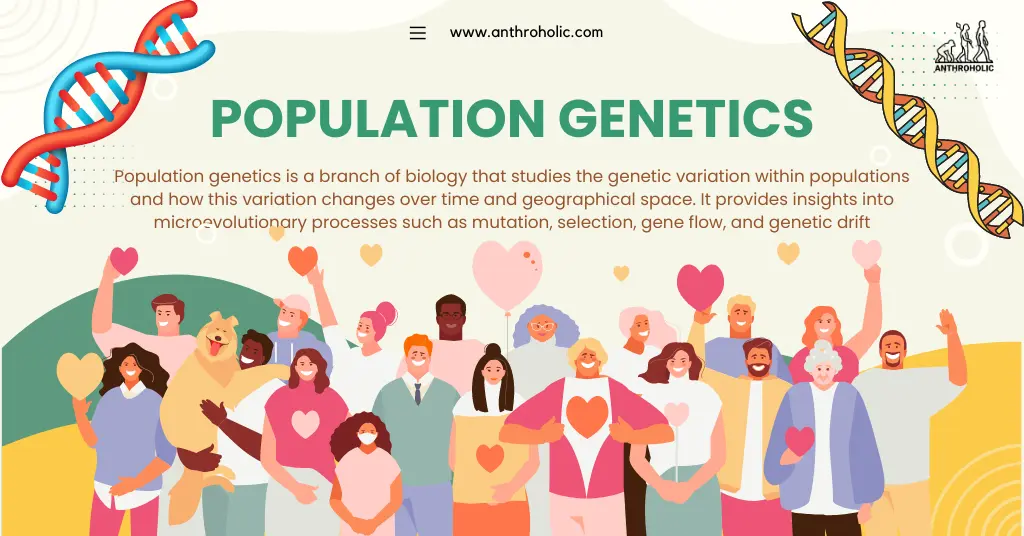AI Answer Evaluation Platform Live Now. Try Free Answer Evaluation Now
Population Genetics
Population genetics is a branch of biology that studies the genetic variation within populations and how this variation changes over time and geographical space. It provides insights into microevolutionary processes such as mutation, selection, gene flow, and genetic drift [1]. Let’s delve deeper into these concepts.

Genetic Variation Within Populations
Genetic variation is the cornerstone of evolutionary change and adaptation. It occurs through three primary sources: mutation, recombination, and gene flow.
- Mutation: Mutations are changes in an organism’s DNA sequence, creating new alleles or variations of genes. These are often random and can be beneficial, neutral, or deleterious [2].
- Recombination: During sexual reproduction, chromosomes can exchange DNA segments, leading to new gene combinations [3].
- Gene Flow: Also known as migration, gene flow occurs when individuals or their gametes move between populations, thus introducing new genes into the population [4].
Forces of Evolutionary Change
Four principal forces drive changes in gene frequencies: natural selection, genetic drift, mutation, and gene flow.
- Natural Selection: This process favors the survival and reproduction of the fittest individuals. It tends to increase the frequency of beneficial alleles and reduce the frequency of deleterious ones [5].
- Genetic Drift: Genetic drift is a random process that can change allele frequencies over time, especially in small populations. It may lead to the fixation or loss of alleles [6].
- Mutation: While typically slow, mutation introduces new alleles into the population, providing material for other evolutionary processes [7].
- Gene Flow: Gene flow can either increase or decrease genetic variation, depending on the differences between the source and the recipient populations [8].
| Forces of Evolution | Increase Variation | Decrease Variation |
|---|---|---|
| Mutation | X | |
| Gene Flow | X | X |
| Genetic Drift | X | |
| Natural Selection | X |
Hardy-Weinberg Equilibrium
The Hardy-Weinberg equilibrium is a fundamental principle in population genetics. It predicts the genotype frequencies of a population over time under specific conditions: no mutation, no gene flow, random mating, no natural selection, and a large population size [10]. If these conditions are met, the allele and genotype frequencies will remain constant from one generation to the next.
Studying Genetic Structure
Genetic structure refers to the distribution of genetic variation within and among populations. Analyzing the genetic structure of a population helps to understand its evolutionary history and potential future [11]. It is often studied using molecular markers like single nucleotide polymorphisms (SNPs), microsatellites, and mitochondrial DNA [12].
Population Genetics in Conservation
Population genetics is essential in conservation biology. By understanding the genetic diversity of a species, scientists can design effective conservation strategies. High genetic diversity typically implies a healthy population, capable of adapting to changing environments, while low genetic diversity may indicate inbreeding and vulnerability to diseases [13].
Methods in Population Genetics
In modern population genetics, DNA sequencing technologies and bioinformatics tools play crucial roles in extracting meaningful information from raw genetic data. These methods include:
- Whole Genome Sequencing (WGS): WGS involves sequencing the entire genome of an organism. This method is especially useful for detecting rare variants and structural changes in the genome [14].
- Genotyping-by-Sequencing (GBS): GBS is a cost-effective method to identify thousands of SNPs across the genome. It’s often used for species whose reference genomes are unavailable [15].
- Bioinformatics Tools: These include software for statistical analysis (e.g., R), alignment of sequence reads (e.g., BWA), variant calling (e.g., GATK), and population genetic analysis (e.g., PLINK, ADMIXTURE) [16].
| Methods in Population Genetics | Strengths | Limitations |
|---|---|---|
| Whole Genome Sequencing | Comprehensive genetic information, detection of rare and structural variants | High cost, requires significant computational resources |
| Genotyping-by-Sequencing | Cost-effective, applicable to non-model organisms | Low coverage, not suitable for detecting structural variants |
| Bioinformatics Tools | Flexible, robust analyses | Require bioinformatics skills, quality of data can influence results |
Population Genetics in Medicine
In medicine, population genetics helps understand the genetic basis of diseases. By comparing the genetic makeup of healthy and diseased individuals, researchers can identify “risk alleles” associated with certain diseases. This approach has led to discoveries of genetic risk factors for numerous conditions, including heart disease, diabetes, and cancer [18]. Understanding these genetic factors can guide personalized medicine strategies, allowing treatments to be tailored to an individual’s genetic makeup [19].
Future Perspectives
Population genetics will continue to grow in importance as technological advances allow for increasingly detailed genetic analysis. As more genetic data become available, the field will likely shift towards understanding the complexities of gene-gene and gene-environment interactions. This knowledge will have far-reaching implications, from conserving biodiversity to treating human diseases [20].
Conclusion
Population genetics plays a vital role in many biological fields, including conservation biology, evolution, and medicine. Understanding how populations change over time can help manage endangered species, understand the spread of diseases, and even shed light on human evolutionary history. As genomics technology continues to improve, we can expect even more exciting advancements in the field of population genetics.
FAQs about Population Genetics
References
[1] Hartl, D. L., & Clark, A. G. (2007). Principles of population genetics (4th ed.). Sunderland, MA: Sinauer Associates.
[2] Eyre-Walker, A., & Keightley, P. D. (2007). The distribution of fitness effects of new mutations. Nature Reviews Genetics, 8(8), 610–618. https://doi.org/10.1038/nrg2146
[3] Otto, S. P., & Lenormand, T. (2002). Resolving the paradox of sex and recombination. Nature Reviews Genetics, 3(4), 252–261.
[4] Slatkin, M. (1987). Gene flow and the geographic structure of natural populations. Science, 236(4803), 787-792.
[5] Darwin, C. (1859). On the origin of species by means of natural selection. London: John Murray.
[6] Kimura, M. (1983). The neutral theory of molecular evolution. Cambridge: Cambridge University Press.
[7] Nachman, M. W., & Crowell, S. L. (2000). Estimate of the mutation rate per nucleotide in humans. Genetics, 156(1), 297-304.
[8] Ronce, O. (2007). How does it feel to be like a rolling stone? Ten questions about dispersal evolution. Annual Review of Ecology, Evolution, and Systematics, 38, 231-253.
[9] Charlesworth, B. (2009). Effective population size and patterns of molecular evolution and variation. Nature Reviews Genetics, 10(3), 195–205.
[10] Hardy, G. H. (1908). Mendelian proportions in a mixed population. Science, 28(706), 49–50.
[11] Whitlock, M. C., & Lotterhos, K. E. (2015). Reliable Detection of Loci Responsible for Local Adaptation: Inference of a Null Model through Trimming the Distribution of FST. The American Naturalist, 186(S1), S24-S36.
[12] Morin, P. A., Luikart, G., Wayne, R. K., & the SNP workshop group. (2004). SNPs in ecology, evolution and conservation. Trends in Ecology & Evolution, 19(4), 208-216.
[13] Frankham, R. (2005). Genetics and extinction. Biological Conservation, 126(2), 131-140.
[14] Goodwin, S., McPherson, J. D., & McCombie, W. R. (2016). Coming of age: ten years of next-generation sequencing technologies. Nature Reviews Genetics, 17(6), 333-351.
[15] Elshire, R. J., Glaubitz, J. C., Sun, Q., Poland, J. A., Kawamoto, K., Buckler, E. S., & Mitchell, S. E. (2011). A robust, simple genotyping-by-sequencing (GBS) approach for high diversity species. PloS one, 6(5), e19379.
[16] Chang, C. C., Chow, C. C., Tellier, L. C., Vattikuti, S., Purcell, S. M., & Lee, J. J. (2015). Second-generation PLINK: rising to the challenge of larger and richer datasets. GigaScience, 4(1), s13742-015.
[17] Luikart, G., England, P. R., Tallmon, D., Jordan, S., & Taberlet, P. (2003). The power and promise of population genomics: from genotyping to genome typing. Nature Reviews Genetics, 4(12), 981-994.
[18] Manolio, T. A., Collins, F. S., Cox, N. J., Goldstein, D. B., Hindorff, L. A., Hunter, D. J., … & Visscher, P. M. (2009). Finding the missing heritability of complex diseases. Nature, 461(7265), 747-753.
[19] Hamburg, M. A., & Collins, F. S. (2010). The path to personalized medicine. New England Journal of Medicine, 363(4), 301-304.
[20] Hedrick, P. W. (2011). Population genetics of malaria resistance in humans. Heredity, 107(4), 283–304.




